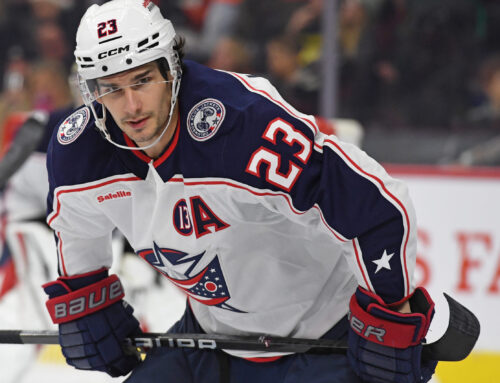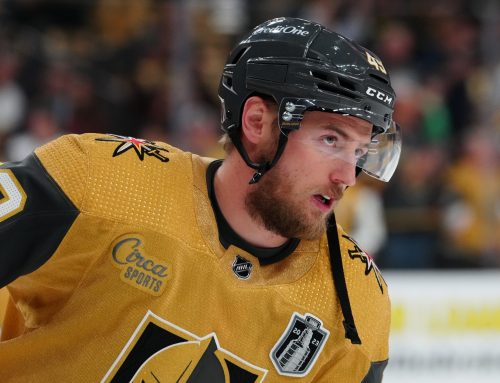Today we are continuing our division sweep. Last week we looked at a few advanced stats and flagged Pacific Division players whose point pace from 2023-24 looked unsustainable (for good or ill). Today we are going to be doing the same with the Central Division.
As a reminder here is some context setting from the earlier article.
In order to make this process a bit more concrete we are going to focus on three stats from the Dobber Reports; five on five team shooting percentage (5on5 S%), individual points percentage (IPP), and individual shooting percentage (S%). These are certainly not the end all be all of player evaluation but do tend to flag players who are likely to see a different point pace in the future.
With all of these stats though it is important to take them in their context. Not just what would an average player do, but how does this number compare to their career numbers? In order to do that I grabbed these data points for the 2023-24 season and am comparing them to each player's recent career average. Broadly speaking, and barring changes in the player's situation (changing teams, sudden promotion to a top line etc.) we would expect these numbers to return that career average.
The first set of players we are looking at are players who performed better than their recent career averages in each of our three stats. A broad statement we can say about each of these players is that there were more goals scored while they were on the ice than usual, they got in on more of those goals than usual, and they themselves scored on a higher percentage of their shots than usual. In short all of these players could be in danger of less point production in 2024-25.
| 5on5 S% | IPP | SH% | ||||||
| Name | Pos | Team | 23-24 | Δ From Average | 23-24 | Δ From Average | 23-24% | Δ From Average |
| MARCO ROSSI | C | MIN | 8.1 | 6.25 | 65.6 | 48.95 | 12.57% | 12.57% |
| JASON DICKINSON | C | CHI | 10.1 | 3.65 | 62.5 | 4.4 | 17.46% | 9.68% |
| EVGENII DADONOV | R | DAL | 8.9 | 0.4 | 67.6 | 9.5 | 17.91% | 8.50% |
| LOGAN O’CONNOR | R | COL | 8.3 | 0.35 | 64.1 | 4.6 | 15.29% | 7.93% |
| TYLER SEGUIN | R | DAL | 11 | 3.8 | 69.3 | 3.35 | 16.23% | 5.18% |
First up I think we can safely disregard Marco Rossi's inclusion on this list. The comparison for him is 19 games in 2022-23 and one game in 2021-22 where he only scored one point, and did not get a goal. Given he actually scored a goal in 2023-24 so of course his shooting percentage is going to be higher than zero. We can take his 2023-24 season as baseline going forward. He has had a long road back to the NHL, but he averaged 16:44 minutes a night and put up two shots per game. His 40-point pace is hopefully a floor he can build off of going forward.
The same is not true for Jason Dickinson, Evgenii Dadonov, and Logan O'Connor. Their 35ish point paces came with some significant good fortune compared to their historical numbers. Sure, they each saw some changes in deployment, whether that was occasional bumps to good lines during a teammate's injury or in the case of Dickinson the highest average time on ice of his career. At the end of the day though it took pretty favorable numbers to be essentially irrelevant, except in very deep leagues for an occasional stream when their deployment or schedule was particularly helpful.
That leaves us with Tyler Seguin. Seguin had a bit of a renaissance during a few portions of the season, and overall landed at a 63-point pace, his highest pace since 2018-19. He seemed to click with new linemate Matt Duchene, but given he is included in this portion of the article we know that it was on the backs of some potentially unsustainable numbers. Duchene is returning for one more season so that is at least one piece of good news. I might be able to excuse his point participation being higher than his recent history as it has been good in other portions of his career, but the team just scored too many goals while he was on the ice. Without a bigger role (which seems unlikely with the emergence of Dallas' young players) he looks like he should be back on track for a 55ish point season.
To switch gears now, let's focus on players who might be due for a bounce back. Again, in a similar analysis process we are looking at players who's shooting percentages and IPP were lower than expected. So basically, we can say all of these players had fewer goals scored when they were on the ice and were getting in on fewer of those goals.
| 5on5 S% | IPP | SH% | ||||||
| Name | Pos | Team | 23-24 | Δ From Average | 23-24 | Δ From Average | 23-24% | Δ From Average |
| BARRETT HAYTON | C | UTA | 6.7 | -2.15 | 30.3 | -21 | 4.55% | -6.61% |
| BRAYDEN SCHENN | R | STL | 9.4 | -1.7 | 56.1 | -12.9 | 11.76% | -5.88% |
| PAVEL BUCHNEVICH | C | STL | 8.6 | -3.3 | 59.4 | -11 | 13.04% | -4.35% |
| NICK SCHMALTZ | R | UTA | 8.9 | -3.35 | 63.5 | -9.65 | 13.92% | -3.72% |
| JORDAN KYROU | R | STL | 9.1 | -2.15 | 70.5 | -7.35 | 12.35% | -1.56% |
It is worth a little time to talk about Barrett Hayton. Hayton was coming into 2023-24 off of his most productive NHL season to date. His overall 43-point pace doesn't tell the full story though. From the end of December through the rest of the 2022-23 season he put up closer to a 65-point pace, was seeing 19 minutes a night overall, and about 65 percent of his team's power play. Fast forward to 2023-24 and he managed only a 25-point full season pace. He was hurt for a bit but clearly something was off. He is on this list because several of his underlying numbers seem too low, so it shouldn't shock anyone to know that it looks like he should have done a little bit better.
The disappointing thing is that it looks 'better' in Hayton's case and is still only 40-point pace at best. It is a far cry from the 65-point pace he saw at the end of 2022-23 that many were hoping he would build off. His future is definitely up in the air. He is right at the 200-game threshold which is a common time for a potential breakout. He is also going to see more internal competition and/or an influx of talent with all of the young players that Utah has been acquiring. He will need top line/top power play deployment to get back to those 65-point heights, but for now 40 points seems a more likely baseline.
Brayden Schenn and Pavel Buchnevich can sort of be grouped together. Both saw some disappointing drops in point production, while keeping a lot of their deployment relatively similar, and maintaining shot rates and expected goal numbers. St. Louis got off to an incredibly cold start so that could have something to do with it. It does look like both Schenn and Buchnevich should see a rebound back to their 2022-23 numbers.
Nick Schmaltz and Jordan Kyrou are also in a similar group. Both saw somewhat smaller drops in overall pace than Schenn and Buchnevich and generally their underlying numbers were also a bit closer to usual. The one major difference here is that Schmaltz's expected goal numbers dipped a bit while Kyrou has gone the other way, and looks even better than historically. Overall, both should rebound a little bit. I will give a little caveat for Schmaltz though. There is a lot up in the air with Utah, and it wasn't great that his expected goal numbers dropped. Everything else looks pretty reasonable for him, so 70-plus points is still on the table, but I am a little more hesitant on his return to form than Kyrou's.
That is all for this week. Do your part to support organizations working to make hockey for everyone.





 PHI
PHI TOR
TOR ANA
ANA NYI
NYI BUF
BUF CGY
CGY VAN
VAN CAR
CAR STL
STL MTL
MTL CBJ
CBJ
